Big Smoke: Occupation Times
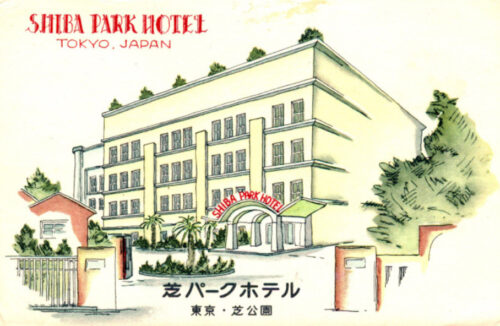
Editor’s Note: Downsizing in the here-and-now of a new year (2023) has caused some joyful chaos. The movement made some forgotten things emerge from the memory locker. Some are a little disconcerting. We started on “The Cracker Caper” as one of them yesterday. It is a story from an extraordinary time. It features Tom “Big Smoke” Duvall’s recollections of “food” distribution and law enforcement in a time when those were controversial issues far away. Our talks then built into a series of exchanges about Intelligence/Law Enforcement in Japan and France. Tom felt they were useful to frame the experiences he had as Chief of the Yokosuka Occupation Police at the outbreak of the Korean War. At the time, we worked it up into two chapters about unconventional work in Japan and the other with the Surete- the French government Security Branch.
Tom was still alive for that. When he passed, there was other material we had not integrated. I found some of it this morning, and it was surprising, since I had not seen it since put that project aside more than a decade ago. It was contained in a folder unseen as it lurched through several hard drives in the years after Tom’s death. It included his words and pictures of what it was like to have been there, on the ground across a big sea. Here are some words from Big Smoke about the experience:
“Upon my arrival (in Japan), I was billeted in the Shiba Park Hotel, where the accommodations were satisfactory though not elegant, but where the American food, served by Japanese waitresses, was tasteful and in good supply. I settled in on December 8 or 9 and on the 10th reported for work in the Radio Tokyo Building, located not far from the hotel. I was now under the indirect command of General MacArthur, the Supreme Commander Allied Powers (SCAP). Though Hirohito retained the title of emperor, it was the American generalissimo who exercised sovereignty in the country. Calm, aloof, dignified, and impressive, the “Yankee Mikado,” as someone dubbed him, sat in the driver’s seat and both earned the respect of the common people and exacted the loyalty and cooperation of Japanese officialdom. He lived in the American embassy and had his office in the Dai Ichi building, where he was surrounded by his immediate staff and deputies.
The difficulty of his task was compounded by the fact that he not only governed Japan but also had jurisdiction over all the Allied forces deployed in the vast Pacific arena. It was under his supervision that four million Japanese soldiers and sailors were demobilized; and it was by his orders that more than five hundred minesweepers were engaged in cleaning the adjacent waters of well-laid mines. It was he, too, who moved the nation toward constitutional democracy, disestablished the state religion, initiated woman suffrage, and got the emperor to disavow his presumed divinity.”
That was the landscape Tom surveyed on arrival in Japan, and that was what I was trying to capture and integrate into what became a story about interrogation, food and social life in an occupied land. We were doing some of the same things in Iraq at the time we talked. Some of it was vaguely familiar, since the Yokosuka I knew in 1978 was still filled with people who had lived the experience. Mostly it was not discussed, though frequent visits to the Philippines made some of the old stories make sense.
Tom called me up from his house on Sugar Hollow Road in 2008. I had some questions for him, since the Japan I experienced was not the same as his. They did share some things in common. Our favorite bar maid in my time was named Sumiko; she could have been the daughter of Kiko, who was one of Tom’s friends in 1949.
They are both part of a sedimentary layer of Japans. Tom’s is laid right over the ash of devastation that covered the brittle rock of the militarist period. That in turn covers the distinct change of color and texture of the Meiji days and Old Edo era, and so on down through the rock to the igneous layer that represents the reign of Jimmu Tennu a gazillion years ago.
Tom was going down the list of questions I had compiled trying to put the Cracker Caper together. I was at my office desk in Arlington, looking down at Glebe Road eight stories below. He slowly read me his e-mail address, which I could not decipher from his note. I thought the middle part was “aloha,” but it wasn’t.
“Nah, it’s MONA,” he growled. “You know what that is doncha?”
“No,” I said.
“I don’t know what they are teaching you guys. Mother Navy. “Mona,” for short.”
“When I was out there they called it “BOHICA.” Bend over, here it comes again.”
Tom snorted. “You have a bunch of questions, and I am going in the hospital tomorrow. You got time to chat? “
I flipped the cover open on my steno pad and fumbled for a pen. “You got my undivided attention,” I said as my PDA vibrated in the holster on my belt.
“First off, you have the timing all wrong. I got to Japan in 1949. August of 1949, not 1950. The Occupation was still going on, and there was all kinds of problems down in Yokoskua. The Navy base was over five hundred acres of US territory in the middle of a couple hundred thousand hungry Japanese. You had questions about sports in Japan as part of a cultural change. They may have decided to start playing baseball up in Tokyo later on, but I will tell you, I didn’t see any goddamned baseball. People were too hungry to worry about crap like that.
We were thin on resources out there. In 1949, there was only one major US combatant ship in WESTPAC, the triple “A” light cruiser St. Paul. That is how things were. It was a big deal when a ship pulled in. So I was there and trained when the North Koreans came across the line up north and the war broke out and everything changed.
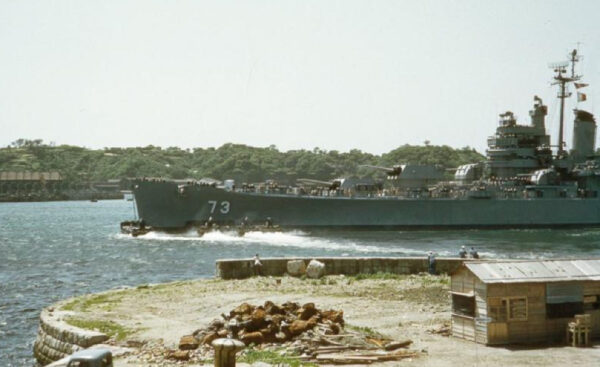
(USS Saint Paul CA-73 arriving at Yokosuka, 1951? Tom shared a bunch of images which I presume were taken with his trusty Argus camera).
With the onset of hostilities in Korea on June 25, 1950, Yokosuka Navy Base suddenly became very important and was transformed from an Occupation Facility to an extremely busy Fleet operations center. The US turned its full efforts to the support of South Korea. The Navy Dispensary was enlarged and expanded and was commissioned a US Naval Hospital in 1950. The Naval Communications Facility, Yokosuka, was commissioned in January, 1951. In April 1951, the Ship Repair Department became a Component Command. It was re-designated the Ship Repair Facility. As the major naval ship repair facility in the Far East, the Yokosuka Facility assumed a vital role in maintenance and repair of the US Seventh Fleet during the Korean and Vietnam conflicts.
In March, 1952, the geographical boundaries of the command of Commander Naval Forces Far East changed to exclude the Philippines, Marianas, Bonin and Volcano Islands. In December, 1952, the Headquarters were shifted from Tokyo to Yokosuka. The expanded Supply Department of Fleet Activities became the Naval Supply Depot, Yokosuka in August, 1952 and in 1960, the Naval Communications Facility was re-designated US Naval Communications Station, Japan. It was a beehive.
The hookers- at least the Rest and Recreation Association ones- were long gone. They didn’t even make it far into 1946. Everyone in Japan had a clap, at least all the Japanese and the sailors that messed around.
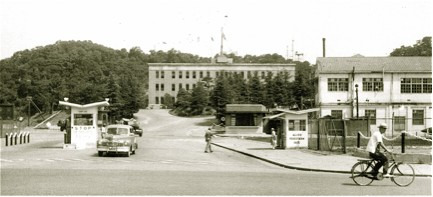
(Fleet Activities Yokosuka Main Gate. Photo Tom Duvall).
“My room is the top left of the building in the picture, I liked looking down at the gate. You could see everything that was going on, which is useful in my line of work. What I was doing was cleaning up the house. I worked off base in civvies. I may have been a Bo’sun’s mate, but I told the Japs who worked for me that “they had the Japanese and I had the Americans.” I couldn’t really tell you what my title was. I was the Inspector, and that worked under Martial Law.”

(Kiko, fully attired).
You asked me about my pal Kiko. She was a tall gal. Father probably a Marine from Hokkaido, since they had to be 6ft. tall, since that was the requirement form the Imperial Navy. The tallest Japanese are from the northern island of Hokkaido. There were documented graves of Europeans who came across Russia that way long ago.
Kiko had big boobs. The Admiral asked me to get a portrait taken of her. I had the trusty Argus, of course- I never went anywhere without it. He wanted something special, though, a studio shot. I picked her up after work and took her to a professional, and we had a nice shot done. She was an elegant looking gal- high neck, and tall, like I said. The Admiral liked the picture, but he motioned me over by the desk and said: “Can you get me one that shows her boobs?”
I said, “Sure,” and Kiko didn’t mind. She did not have any of that bullshit modesty like we do back home. I got my pal to take the picture with her chest exposed and a demure look on her face like butter would not melt. The Admiral really liked it. He got someone in the office that could draw Japanese to do some characters on it so it was pretty exotic, I guess. I wish I’d kept a copy of the picture. She was one fine-looking woman, and had that touch of Hokkaido about her figure that was very appealing.
I was not much for keeping souvenirs, and what I have now is a result of sending stuff home to my dear Mother, who kept it all these years. Now that I am living in her house it is all around.
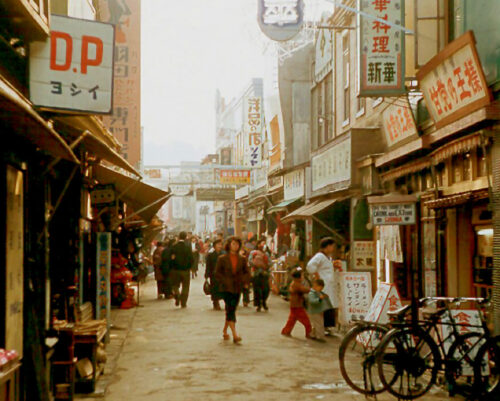
(Yoko street scene)
God, I had the chance to get all kinds of stuff. I had a key to the warehouse, and there were thousands of confiscated weapons in there, and piles of swords. I’m not talking about the ones they made for the war that looked like Samurai swords. They were a dime a dozen. The ones that you were always on the look-out for were the heirloom weapons that some of the young kids had mounted with regulation hilts, but were hundreds of years old, made by some of the great craftsmen of the art.
My guys on the police squad knew how to knock the little wooden pin out that held the handle on the tang, and they could read the kanji inscriptions hammered into the steel. Some of those blades were works of art, and there were piles of them in the warehouse. Every time some visiting fireman would hit Yoko the Admiral would ask me to get a sword as a present-o, and it was not a problem. We had hundreds of them.
Like I said, I got there in 1949 and had to figure out the ropes myself. Captain Decker had been there since the very beginning of the Occupation, and there was every indication that he would be there as long as he wanted, and he liked how he was able to live.
People really loved the guy, and he had some great qualities. He did an enormous amount for the people of Yokosuka, but it was Ali Babba and the 40 thieves out there. I knew things were not completely right when I found some receipts for fuel oil that had gone missing. It was for hundreds of gallons and signed for by the PWC Department head- a Commander, though I have forgotten the name.
I took the hand receipts to show the Admiral, He took them from me, and ripped them up and tossed them in the shit-can. He said: “That fuel was contaminated with water and had to be surveyed.”
I knew what the deal was right then. I told you about the tunnels under the base fence and the way things had of disappearing.
Oh, you asked about the Hooker thing- there weren’t any. The Jap gals danced at the Grand Shima, and a lot of places. If they liked you they would sleep with you. They weren’t hooking, per se, they just needed to get by and they looked at things different.”
The Grand Shima, now that was a place. It looked like a big warehouse, and it got started right at the outbreak of the Korean War by the Brit who owned it. That was a wild time. I gotta tell you there was panic. The Marines at the barracks were getting suited up and shipping out as fast as they could. Some of the Army soldiers they sent had never heard a shot fired in anger, just occupation jockies thrown into the meat grinder.
One night I got a call to go to the base. Four or five of the wives whose husbands had shipped out killed themselves. The dependent families were getting shipped out. There was a feeling that the Japs could rise up against us and take back their government. Didn’t happen that way. Remember, I was just a Bos’un third at that point, civilian clothes, but my division of labor with my Japanese police was that I had the Americans and they had the Japanese.
I had my camera there, and that is a story all by itself. There was a time the Japs didn’t make cameras. Though it is hard to believe now, a pal gave me one of those Argus 3C cameras, made by the Argus Company, of Ann Arbor Michigan. the little boxy things that were the best damn 35mm camera in the world for years. They were a little range-finder camera, and I had the flash attachment for it.
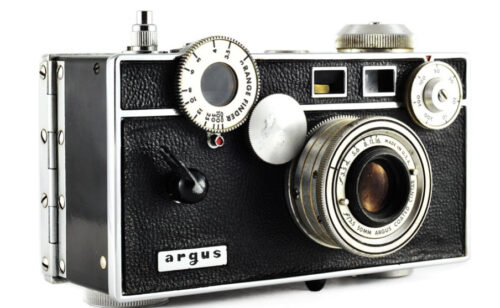
I didn’t have a plan for it, it just seemed like a good idea to have it in such an exotic place. After a while I carried it everywhere. Due to the shape and weight, we called it “the brick.” My Japanese guys called “the lunchbox.” It was made out of Bakelite plastic with metal castings and it had a bunch of buttons and dials and levers. I got to be a regular WeeGee with the thing, and some of the subjects were even the same.
My office was just to the right out the gate at police headquarters. We were only about two blocks away from the docks, and I could hear something happening down there I was a little jumpy- everyone was, so I took the Service .45 out of my desk and put it on top and started to write a note to my dear Mother.
I could hear voices coming closer to the building and then it stopped and got quiet. Mauri, my assistant, came in after a few minutes, and he was holding a scroll. It had the names of all the Stevedores on it, and the military occupations they had done during the War. All my police had signed the thing, too, and instead of wanting to overthrow the Occupation, they wanted to sign up to go fight for MacArthur in Korea ‘cause they hated those bastards so much. The General could have raised a million troops if he wanted to. The Japanese loved him that much. Stupid the way it worked out, but we seem to do a lot of stupid things.
That was something MacArthur took care of first. He had a great pal who might have been one of his classmates. He got out. The Japs like to shoot their drugs. All the pharmacies had needles, that is why we thought they were doing drugs. They just liked needles. Don’t know why, hypos were everywhere.
Everyone had VD at the beginning, and it was still rampant, that was one of my parts of the job. I would get a call from the civilian hospital on the Economy and they would let me know how many eds they had, and I would round up some marines and go to the geisha area and round up that many girls. They would keep them in the hospital and feed them penicillin until they got better and then let ‘em go.
You had to have the Marines with you if you were rousting some woman out of the sack with a sailor.”
Copyright 2023 Vic Socotra
www.vicsocotra.com
